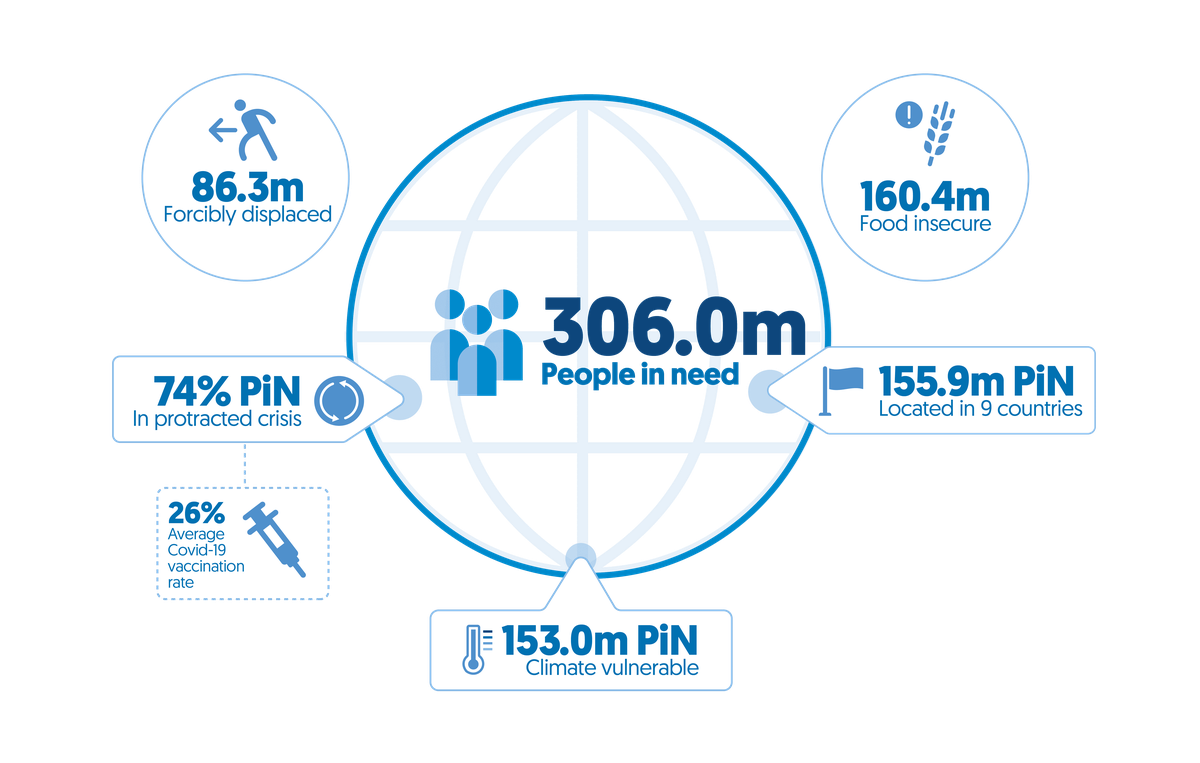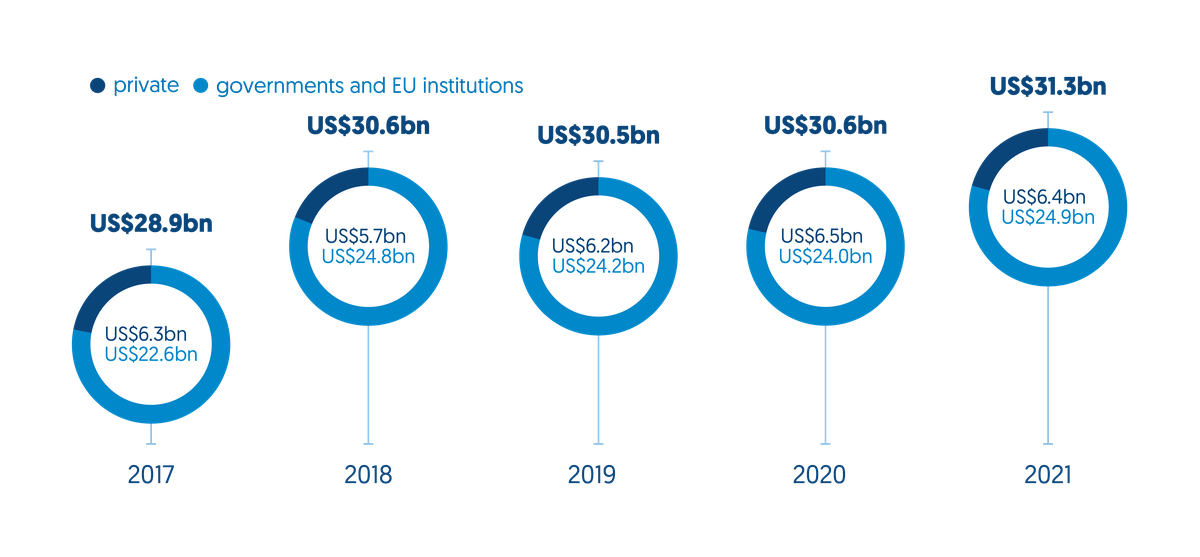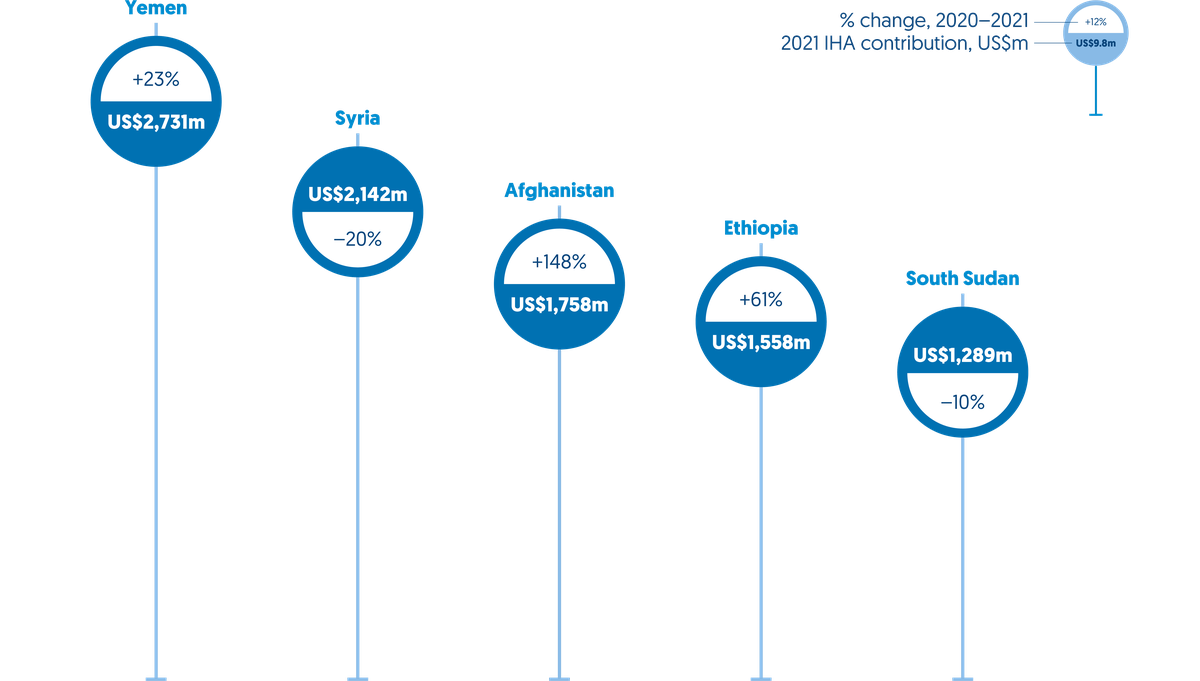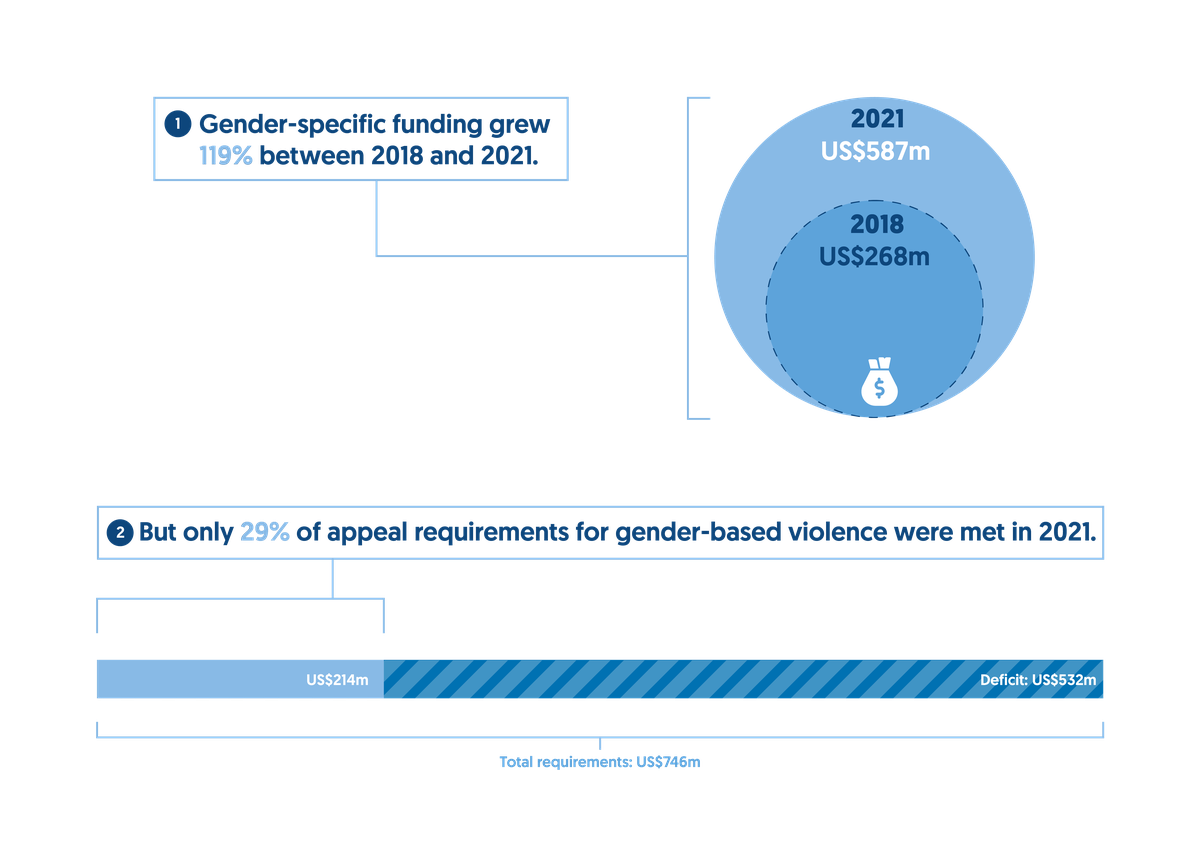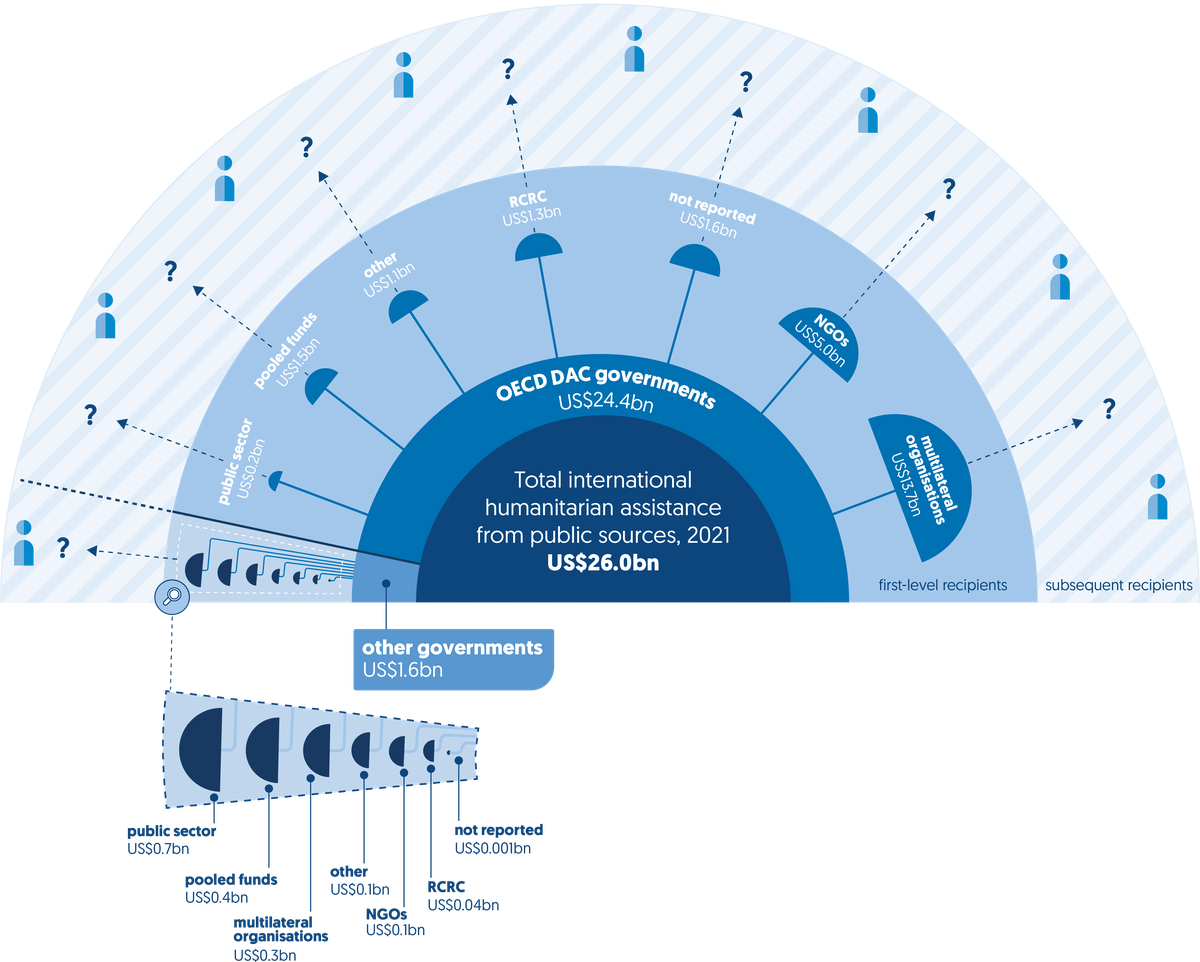Read our new report on humanitarian funding and reform
Our report 'Falling short? Humanitarian funding and reform' presents the latest data on global humanitarian assistance, as well as progress on Grand Bargain localisation targets, cash and voucher assistance, and anticipatory action.
Read the reportIn 2021, the Covid-19 pandemic continued to overlay other pre-existing and emerging crisis risks, driving need and complicating response. Following the rapid rise in demand for humanitarian assistance in 2020, needs remained at historically high levels in 2021. Growth in the volume of total international humanitarian assistance has stalled, with only slightly more provided in 2021 than in 2018.
Despite the rapidly evolving context of humanitarian need driven by the Covid-19 pandemic, the ongoing impacts of climate change and emergent conflict (for instance, in Afghanistan in 2021 and in Ukraine in 2022), the picture of humanitarian financing has altered remarkably little in recent years. The Global Humanitarian Assistance Report 2022 highlights the key trends in how much assistance there is, who is providing it and how. It re-enforces the imperative for change to the sources, structures and methods of humanitarian funding, and to the manner and extent of engagement with and targeting of wider sources of finance – developmental and climate-related – to countries vulnerable to and experiencing crisis.
In 2021, Covid-19 overlaid other pre-existing and emerging crisis risks as humanitarian needs remained at historically high levels.
- In 2021, the number of people in need of humanitarian assistance increased. An estimated 306.0 million people were assessed to be in need, 90.4 million more than in 2019 before the Covid-19 pandemic. Half of those requiring humanitarian support (155.9 million) lived in just nine countries.
- Long-term crisis is increasingly normal. The number of countries experiencing protracted crisis rose to 36 in 2021. These countries were home to three quarters (74%) of all people in need.
- Those experiencing humanitarian crisis have been left behind in efforts to recover from the Covid-19 pandemic. The average Covid vaccination rate is 26% for countries experiencing protracted crisis, compared to 64% for countries without a UN-coordinated humanitarian appeal.
The Covid-19 pandemic has complicated response to an already complex picture of intersecting climate, conflict and socioeconomic risks, with food insecurity and displacement continuing to increase.
Multiple drivers of crisis intersect, compounding the risk of and exposure to crisis. Climate change acts as both a driver and multiplier of crisis risks, with those already in need of humanitarian assistance particularly vulnerable.
- In 2021, half of all people in need (50%, 152.6 million people) were living in countries with high levels of vulnerability to the impacts of climate change.
The intersection of climate risk with socioeconomic fragility and high-intensity conflict is particularly important.
- Two fifths of people in need (39%, 119.9 million people) were living in countries facing a combination of high-intensity conflict, high levels of socioeconomic fragility and high levels of vulnerability to the impacts of climate change.
- High levels of fragility and conflict can limit access to climate resources, at the same time also increasing climate risk, and in turn creating more fragility and increasing the risk of further conflict. Almost three quarters (217.7 million, 71%) of people in need are living in countries experiencing high-intensity conflict.
Covid-19 has led to increased food insecurity. Rising food prices in 2022, driven by the conflict in Ukraine, are posing further threats to food security.
- In 2020/2021, the number of people experiencing food insecurity (food crisis, emergency, or famine) grew rapidly, rising to 160.4 million, a third more than in 2019/2020.
The number of forcibly displaced people continues to rise.
- In 2021, the number of forcibly displaced people increased to 86.3 million people, 5% higher than in 2020.
- This picture already looks different in mid-2022, as the outbreak of war in Ukraine has displaced an estimated 12.8 million people so far.
In 2021, international humanitarian assistance reached US$31.3 billion, but growth has stalled in recent years.
Despite humanitarian need increasing rapidly in the past two years, growth in total international humanitarian assistance has stalled. Governments, in particular, are faced with increasingly difficult choices related to their wider aid budgets, challenges exacerbated in 2022 by the conflict in Ukraine, with clear risks to development and humanitarian assistance.
- In 2021, total international humanitarian assistance increased by US$0.8 billion to US$31.3 billion.
- Between 2012 and 2017, international humanitarian assistance grew annually by more than 10% but it has grown by just 2.6% in the four years since then
Where does it come from?
Largest five donors by volume, 2021

| Donor | 2021 | %Change |
|---|---|---|
| US | 9,767.9 | +12.3% |
| Turkey* | 5,586.7 | -23.3% |
| Germany | 3,165.9 | +11.2% |
| EU institutions** | 2,921.0 | +10.9% |
| UK | 1,596.7 | -38.9% |
| Japan | 1,210.8 | +103.8% |
| Sweden | 954.3 | -5.6% |
| Canada | 752.4 | +11.6% |
| UAE | 745.5 | +74.2% |
| Netherlands | 680.0 | +2.4% |
| Italy | 665.0 | +23% |
| France | 649.4 | -4.6% |
| Norway | 591.7 | -8.9% |
| Saudi Arabia | 552.8 | +86.7% |
| Switzerland | 523.1 | -23% |
| Belgium | 454.2 | +26.6% |
| Spain | 374.5 | +8.9% |
| Denmark | 362.2 | -32.6% |
| Australia | 268.9 | +2% |
| Ireland | 263.5 | +16.8% |
| Finland | 195.9 | +1.6% |
| Austria | 191.6 | +42.2% |
- Funding from governments and EU institutions rose by US$0.9 billion, from US$24.0 billion in 2020 to US$24.9 billion. Driving this growth were increases in excess of 10% by the two largest donors, the US and Germany, counter-balancing a second large annual reduction in funding from the UK, a decrease of US$1.0 billion to US$1.6 billion, 39% less than in 2020.
- Estimates for 2021 indicate that funding from private donors fell slightly from the highest recorded volume in 2020 of US$6.5 billion to US$6.4 billion.
Where is it going?
Largest five recipients by volume, 2021
- Most international humanitarian assistance was allocated to a small number of crises in 2021. The 10 largest recipients received 60% of country-allocable international humanitarian assistance, with Yemen receiving the largest volume of support, US$2.7 billion (12% of all funding).
As humanitarian need has increased, more official development assistance (ODA) has been targeted to countries experiencing crisis but pressures on wider aid budgets are increasing.
- Total ODA from DAC members to countries experiencing protracted crisis has grown by over a third in the past decade, with humanitarian assistance a greater share of total ODA (9.4% in 2012, 14% in 2021).
- Spending on in-country donor refugee costs by DAC members reduced for the fifth consecutive year, to US$8.7 billion in 2021. However, estimates for 2022, as many European donors take in Ukrainian refugees, suggest funding on domestic refugee hosting could be double or triple the previous peak in 2016 of US$17.2 billion.
Historically high levels of need and shortfalls in funding in 2020 were largely mirrored in 2021.
Analysis of UN-coordinated appeals indicates the adequacy of funding to meet identified needs.
- In 2021, a total of US$38.4 billion was requested through UN-coordinated appeals in 2021, just US$895 million less than in 2020 but still US$7.9 billion more than in 2019. Funding was requested for 48 UN-coordinated appeals, again lower than 2020 (55 appeals) but still a third higher than 2019 (36 appeals).
- These appeals received only 56% of identified requirements, up from 51% in 2020. This is the second-highest shortfall ever in the volume of funding provided, US$16.9 billion, slightly less than 2020’s US$19.1 billion.
Gender-related humanitarian funding has grown but still fails to meet needs.
Gender-related humanitarian needs are considered to have grown rapidly, with the Covid-19 pandemic reported to have reversed previous gains in gender equality and the empowerment of women and girls.
- Funding specifically targeted to gender grew from US$268 million in 2018 to US$587 million in 2021.
- Reporting on gender-based violence, an area of gender programming where data is available on the proportion of funding requirements met, indicates that just 29% of funding was provided in 2021.
Developmental and climate-related financing has a potentially important role to play in building resilience to and enabling recovery from crisis.
As the concentration of poverty in crisis-affected countries grows, multilateral development banks are choosing to target a growing share of resources to these countries through traditional financing and a growing number of crisis-focused instruments and tools.
- The volume of ODA provided by multilateral development banks to the annual largest 20 recipients of humanitarian assistance has doubled since 2015 from US$5.8 billion, to US$11.6 billion in 2020.
- The World Bank in particular is providing more financing through crisis-focused mechanisms, which increasingly intersect with traditional humanitarian response. For instance, in 2021, the International Development Association’s Fragility, Conflict and Violence Envelope provided US$2.3 billion to nine countries with humanitarian response plans.
As the number of climate-driven and climate-related disasters continues to rise, climate finance could present one option for alleviating the pressure on humanitarian systems.
- Climate finance is heavily focused on anticipatory action, and a small proportion of climate finance goes to countries already at risk of multiple crises in fragile and conflict-affected states.
- The 34 countries experiencing protracted crisis in 2020 received a total US$1.6 billion in adaptation funding, less than 3% of their total bilateral ODA funding (US$56.8 billion), and 27% (US$6.0 billion) of climate-relevant ODA for adaptation purposes.
- Only 12% (US$1.3 billion) of disbursed funding from multilateral climate funds (US$10.7 billion) goes to fragile and conflict-affected states.
- No clear financing mechanism yet exists to diminish the climate losses and damages communities face, transferring the costs of disasters to local actors or the humanitarian system.
The landscape of humanitarian needs is evolving at pace and the need for reform is widely recognised. However, change continues to be slow, with progress evident on only some key issues.
Despite many years of rhetorical commitments to alter funding behaviour, the patterns of funding from public donors have not changed in the past decade, with only minor shifts evident year-on-year. Funding to multilateral organisations still constitutes the majority of assistance from public donors in 2021.
A second phase of the Grand Bargain process was launched in 2021, to speed reform in the delivery of humanitarian assistance. But progress on priority commitments was, as in previous years, uneven.
- Significantly less funding was provided directly to local and national actors in 2021. Following an increase in 2020, direct funding reduced by almost two thirds, to the lowest volume (US$302 million) and proportion (1.2%) of total international humanitarian assistance seen in the previous five years.
- A central feature of quality funding is flexibility. However, the proportion of unearmarked funding received by nine UN agencies declined to its lowest level in six years of tracking, falling to 13% of total funding received, following an increase in 2020.
- More positively, preliminary data on global humanitarian assistance in the form of cash or vouchers shows that the volume transferred to recipients rose to US$5.3 billion in 2021, an increase of 3.7% from 2020. When final accounts are complete, cash and voucher assistance is likely to have accounted for 21% of total international humanitarian assistance in 2021.
Cash and voucher assistance, 2016–2021
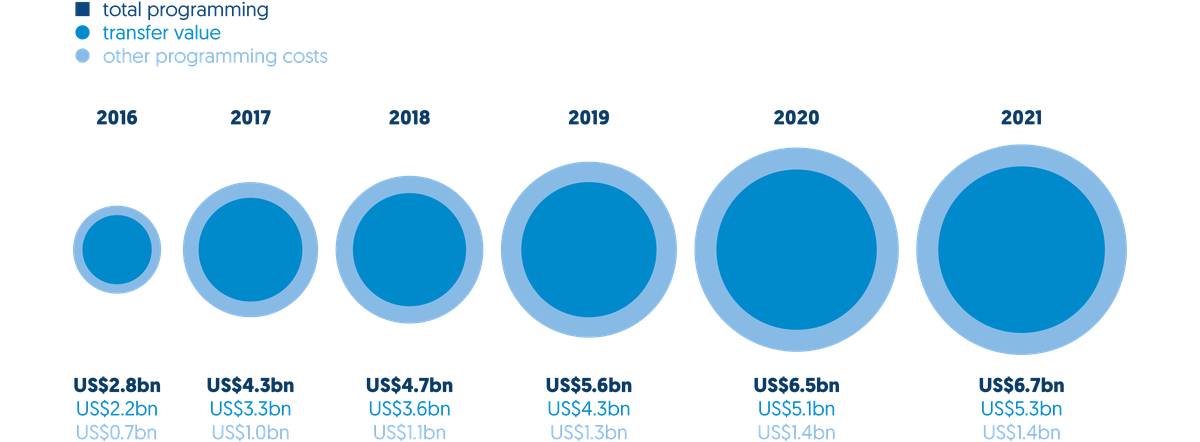
| 2016 | 2016 | 2017 | 2017 | 2018 | 2018 | 2019 | 2019 | 2020 | 2020 | 2021 | 2021 | |
|---|---|---|---|---|---|---|---|---|---|---|---|---|
| Transfer value | Total programming | Transfer value | Total programming | Transfer value | Total programming | Transfer value | Total programming | Transfer value | Total programming | Transfer value | Total programming | |
| NGOs | 0.6 | 0.7 | 0.7 | 0.9 | 0.7 | 0.9 | 0.8 | 1.0 | 1.3 | 1.5 | 1.1 | 1.4 |
| RCRC | 0.1 | 0.1 | 0.8 | 1.0 | 0.7 | 1.0 | 0.8 | 1.1 | 0.9 | 1.2 | 1.0 | 1.2 |
| UN agencies | 1.5 | 2.0 | 1.7 | 2.2 | 2.1 | 2.8 | 2.7 | 3.5 | 2.9 | 3.8 | 3.2 | 4.1 |
| Other | 0.003 | 0.004 | 0.1 | 0.1 | 0.01 | 0.01 | 0.001 | 0.002 | 0.004 | 0.01 | 0.001 | 0.001 |
| Total | 2.2 | 2.8 | 3.3 | 4.3 | 3.6 | 4.7 | 4.3 | 5.6 | 5.1 | 6.5 | 5.3 | 6.7 |
